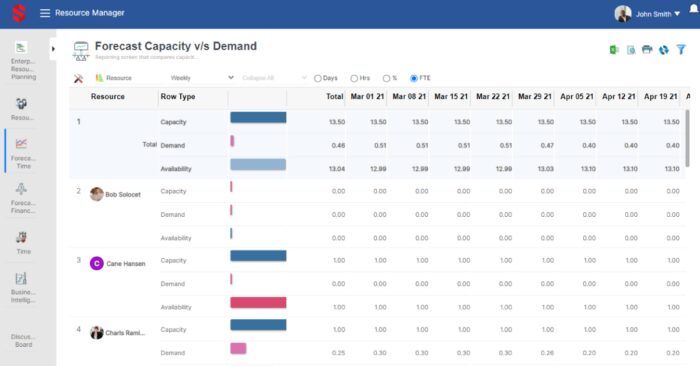
“The future belongs to those who learn more skills and combine them in a creative way.” ~ Robert Greene, an American author.
Rightly said. The global business landscape is rapidly transforming due to emerging technologies like automation, artificial intelligence, machine learning, etc. This has led to the emergence of new skill requirements and roles in organizations.
Therefore, to futureproof the workforce and prevent skill gaps and obsolescence, both employees and organizations need to ensure that they are equipped with the latest skillset and knowledge. One of the methods to futureproof the workforce is multiskilling.
Multiskilling enables resources to gain expertise in multiple fields and go beyond their immediate role. It ensures better flexibility, high productivity, enhanced performance, better work quality, and more.
This blog discusses the importance of multi-skilling, the best strategies to future-proof your workforce, and how SAVIOM’s resource management software can help.
So, let’s get started.
Why is multi-skilling important to future-proof your workforce?

Multi-skilling is a practice that helps employees learn and acquire diverse skills and competencies besides their primary ones. It helps employees hone their existing skills and learn additional skills through hands-on experience, training programs, and development opportunities.
Multiskilling is beneficial for an organization in a number of ways. It enables them to tap into employees’ maximum potential and also enhance their operational efficiency and productivity, thereby improving organizational growth and development.
At the same time, it helps managers identify the right employees capable of acquiring varied skills and multiple roles. This makes it easy to determine the candidates suitable for promotion instead of hiring external resources and minimizing resourcing costs.
Multi-skilling promotes interactions between employees from various departments, facilitating an environment of good collaboration and coordination. Developing additional skill sets also helps a company diversify employees’ portfolios, and reduce dependence on a few critical resources. It also makes them ready to take on multifaceted projects, cater to evolving demands, and future-proof them against market volatility.
Now that the significance of multi-skilling is understood, let’s understand the best strategies to implement it to make the workforce future-ready.
5 Best Practices to Build a Futuristic Workforce
Here are several ways to implement a multi-skilling program effectively.
1. Identify new skill requirements and skill gaps
As the global market trends are continuously evolving and the demand for new skills is on the rise, companies must identify and assess skill demands in their respective industries.
Managers can also track pipeline projects and perform gap analysis by assessing the nature of skill demands vs. the competencies of the existing workforce. It helps them identify the existing skill gaps and document them. Eventually, a plan can be created to bridge these capacity gaps and build a workforce with in-demand skills.
2. Create a training and upskilling calendar
After identifying the skill gaps, managers must create a strategy and outline various learning methods to implement for multi-skilling. In addition, they must also decide on the timeline, schedule, budget, and other parameters for the training. The end goals and objectives of the training must also be elucidated and conveyed beforehand.
Managers also need to ensure that the training materials are up-to-date and in line with roles and current demands. Finally, before implementing the multi-skilling program, one must make sure to align the training timeline with employees’ schedules and availability to avoid overwork and burnout.
3. Encourage multi-skilling with an IDP for every employee

While encouraging multiskilling, the management must consider employees’ diverse skills, competencies, proficiency levels, and career aspirations. For that, managers can consider creating an Individual Development Plan (IDP) to help employees with their career goals while ensuring that the skills learned align with the company’s vision.
Managers can also assess various training methods and models, including peer-to-peer coaching, reverse mentoring, online courses, blended learning, seminars, etc. Based on the employee’s learning style, preference, capability, etc., they can select the best-fit methods for employees’ IDPs. Multiple learning options allow employees to select programs of their preference, ensure higher participation, and acquire multiple skills through experts in different fields.
4. Implement on-the-job training or shadowing programs for multi-skilling
In every organization, some employees are already equipped with competencies that partially match the required skill sets. So, an extensive coaching program might be unnecessary. In this case, companies can implement an on-the-job training approach for them. It will help them gain more experience in their primary skills while acquiring new ones by working in a real environment.
One prominent type of on-the-job training is shadowing, which enables interested employees to follow and observe another employee performing a given role. This type of learning is ideal for new employees or interns to help them understand the nature of the job better and self-evaluate their competence for the same.
5. Offer job rotation and cross-departmental opportunities
Providing hands-on experience forms an essential aspect of a multi-skilling program. So, managers can offer job rotation and cross-departmental opportunities for the same. Employees can work on short assignments or projects from departments other than their core ones at regular intervals. These opportunities help them understand the nature of jobs in other functions and learn or refine their secondary skills.
Besides, giving exposure to different verticals of the company benefits an organization as the workforce becomes competent enough to work on multifaceted projects. For employees, it helps break the monotony of mundane tasks and engage them with new learning opportunities.
Given the strategies to build a future-ready workforce using multi-skilling, the following section describes how resource management software can help.
How can resource management software help future-proof the workforce?
The enterprise-wide visibility helps get an overview of the existing workforce’s skills and competencies, experience, etc., and assess where it stands in terms of market readiness. Managers can also consider these attributes to customize individual development programs for employees and align them with the company’s strategic vision.
The capacity-vs-demand reports give a clear idea of pipeline project demands and determine the skill gaps across the organization and help managers initiate the right resourcing measures to fill them proactively.
The business intelligence reports like utilization and availability help understand the resources’ bookings and decide on the training schedule accordingly to prevent burnout. All these features cumulatively help an organization to build the best multiskilling program for the employees.
Conclusion
In today’s hyper-competitive business scenario, companies face resource crunch, high resourcing costs, market volatility, etc. Therefore, implementing multi-skilling paired with a resource management tool is the key to staying competent and sustainable. This not only helps future-proof the workforce to make an organization immune to economic uncertainties but also engages it to increase retention rates.
So, are you ready with an effective multi-skilling program for your firm’s workforce?

















